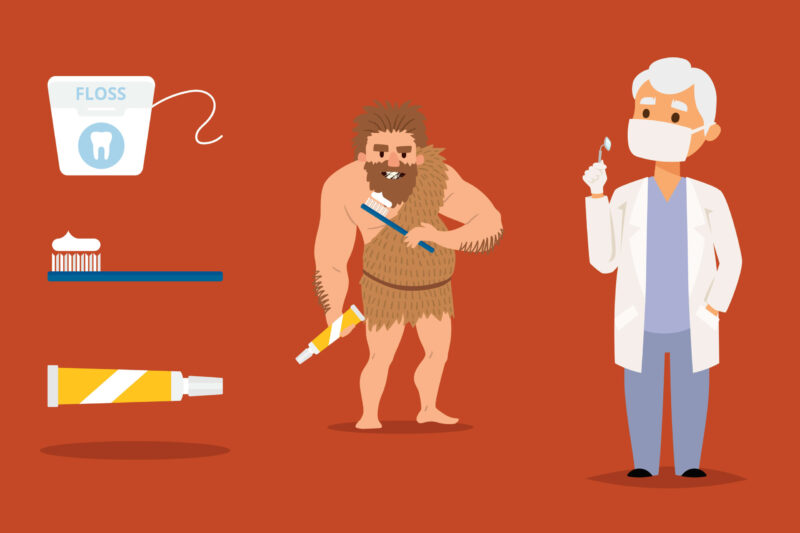The field of dentistry has come a long way from its humble beginnings. Today, we enjoy the benefits of advanced dental care, but do we ever wonder about the journey that got us here? In this blog post, we will take a fascinating look at the history of dentistry, from its inception to the revolutionary breakthroughs that shape the practice today.
Timeline of the History of Dentistry
The practice of dentistry has changed over the course of history and evolved with the times. Here is a timeline of the history of dentistry over the ages.
The Dawn of Dentistry: Ancient Dental Care
The earliest recorded evidence of dentistry dates back to 7000 BC in the Indus Valley Civilization. Dental drillings were found in the teeth of skulls at an excavation site, making it the oldest known instance of dental surgery.
Ancient Egyptians, not to be left out, also made significant strides in the early history of dentistry. The first known dentist, Hesy-Re, lived around 2600 BC and was heralded as “the greatest of those who deal with teeth, and of physicians.” Papyrus texts describing dental treatments, such as the treatment of dental decay and gum diseases, further attest to their early mastery of dental care.
Middle Ages: Misunderstandings and Misconceptions
In the Middle Ages, the understanding of dentistry was greatly distorted. Most dental ailments were attributed to tooth worms, a mythological creature believed to bore into teeth and cause pain. Treatments often involved superstitions, prayers, and dubious remedies.
Barber-surgeons, who performed various minor surgeries and bloodlettings, were the primary providers of dental care during this period. By the 1400s, some barber-surgeons began specializing in dental procedures, marking a gradual shift towards professional dentistry.
18th Century: Birth of Modern Dentistry
The 18th century heralded a new era in the history of dentistry. Pierre Fauchard, known as the ‘Father of Modern Dentistry,’ published “Le Chirurgien Dentiste” in 1723, which was the first comprehensive guide to dental care, disease, and treatment.
Fauchard introduced many concepts still fundamental to modern dentistry, including the use of dental fillings and the creation of dentures. He also debunked the myth of the tooth worm, leading to a more scientific approach in dental care.
19th Century: Technological Advancements and Rise of Dental Schools
The 19th century brought about a slew of advancements in dentistry. The first dental school, Baltimore College of Dental Surgery, was established in 1840, leading to the professionalization of the practice.
The use of anesthesia in the 1840s revolutionized dental surgery, significantly reducing pain and discomfort. In 1895, Wilhelm Conrad Roentgen discovered the X-ray, paving the way for a new era in dental diagnostics.
20th Century to Present: Golden Age
The 20th century saw even more revolutionary developments in the history of dentistry, including fluoride and 3D printing, which will be discussed in more detail in the following sections.
The advent of dental implants in the mid-20th century also marked a major turning point in restorative dentistry. Today, we benefit from advanced imaging techniques, laser treatments, and even robotic assistance in dental procedures. The rise of cosmetic dentistry has also led to an increased focus on the aesthetic aspect of dental health.
Fluoride
Fluoride toothpaste, which plays a significant role in preventing tooth decay, was introduced in the early 1900s. Fluoride’s journey in the history of dentistry began in the early 20th century, marking a significant milestone in the history of dental health. In the 1900s, dentists observed that people in certain areas had fewer cavities. After rigorous research, it was concluded that fluoride naturally occurring in water was responsible for this improvement in dental health.
The first fluoride toothpaste, ‘Crest,’ was introduced by Procter & Gamble in 1955, after studies showed that fluoride could be effectively incorporated into toothpaste to prevent tooth decay. By the mid-20th century, water fluoridation became a common practice in many countries, leading to significant improvements in public dental health. Today, fluoride is a crucial element in modern dentistry, recognized for its protective role against tooth decay.
3D Printing
3D printing made its grand entrance into dentistry in the early 21st century, transforming dental practice as we know it. This innovative technology brought about new possibilities in dental restoration, orthodontics, and surgery.
The history of 3D printing in dentistry began with the creation of dental models for study and planning complex procedures. It wasn’t long before dentists started using 3D printed surgical guides for precise implant placement, leading to improved patient outcomes.
In recent years, 3D printing has been used to produce dental prosthetics, including crowns, bridges, and dentures, right in the dental office. This has significantly reduced the turnaround time for dental restorations, improving patient experience.
The history of 3D printing in dentistry is still being written, as technological advancements promise more innovative applications in dental care, truly signifying a revolutionary era in the history of dentistry.
Looking Towards the Future of Dentistry
The history of dentistry is a testament to human ingenuity and the continuous quest for better healthcare. While we’ve come a long way from using flint tools for dental drilling, the journey is far from over. As technology continues to evolve, the future of dentistry holds even more promise and potential.
Remember to stay curious and keep smiling as we continue to uncover the ever-evolving history of dentistry!
Our team of experienced professionals is committed to helping you achieve optimal oral health and a beautiful smile! Contact our friendly dental staff or request an appointment at All Smiles Care for all of your family’s dental needs.


